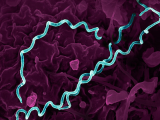In an annual data update on sexually transmitted infections (STIs), US syphilis infections continued an alarming steady rise, overshadowing glimmers of good news about a drop in gonorrhea cases—the first in nearly a decade—and a leveling out of chlamydia infections.
The new data cover 2022, with 2.5 million cases reported to the Centers for Disease Control and Prevention (CDC), similar to the previous year. The CDC said the most alarming concerns are epidemics of syphilis and congenital syphilis, which point to an urgent need for swift innovations and collaboration between all STI-prevention groups.
"As STI services and related resources continue to rebound from the U.S. COVID-19 pandemic and mpox outbreak, we must act now to mobilize and execute a whole-of-nation approach if we hope to turn the tide," the CDC said.
Stillbirths, infant deaths up sharply
Syphilis cases at all life stages rose 17% in 2022 compared to the previous year, with congenital syphilis cases up sharply, by 30%, though slightly lower than the 32% rise the CDC saw in 2021. Since 2018, overall syphilis cases have risen nearly 79%, with congenital cases up a staggering 183.4% over the same period. Over the past decade, congenital syphilis cases have risen 937%.
Congenital syphilis, which occurs when mothers pass the infection during pregnancy to their newborn, can result in serious health problems, including musculoskeletal deformities, neurologic problems, and metabolic dysfunction. Maternal infections can also lead to miscarriage, premature birth, or death.
The CDC said there were 282 stillbirths and infant deaths in 2022, up sharply from 220 in 2021.
In its analysis, the CDC said some states and demographic groups were hit harder than others. For example, Texas, California, Arizona, Florida, and Louisiana had 57% of all reported congenital syphilis cases. Nearly every state, however, reported at least one case.
American Indian and Alaskan Native groups had the highest rates of congenital syphilis, with Black and African American people experiencing about 30% of cases.
Epidemic at tipping point
In an attached statement, Laura Bachmann, MD, MPH, acting director of the CDC's STI prevention division, said the STI field has reached a tipping point, and decades-old prevention strategies are no match for the worsening epidemic.
"There are no shortcuts, and we have to meet people where they are," she said. "Some people face tremendous barriers to STI prevention and health services. So, the most important work is often outside the clinic, whether it be reaching out to communities with testing, interviewing patients to offer services to their partners, or delivering treatment directly to someone."
With the release of the new data this week, the National Association of County and City Health Officials (NACCHO) called for more testing and immediate preventive treatment, with local health departments identifying counties with high syphilis rates and setting up injectable treatment delivery programs.
”Additionally, rapid syphilis testing and treatment, especially during pregnancy, should be encouraged in all emergency departments, syringe service programs, prisons/jails, and maternal and child health programs," NACCHO said.
Also, the National Coalition of STD Directors said the CDC data highlight the need for more federal funding to slow the rapidly growing STI crisis.
It said the newly announced federal syphilis taskforce and the limited import of Extencilline from France are steps in the right direction. "But the nation needs a response that fully meets the moment: one that pairs the new attention from HHS [Health and Human Services] with the resources communities need to restore last year's public health workforce cuts and implement the basic screening and treatment services HHS recommends."
CDC probes reason for gonorrhea decline
Regarding the drop in gonorrhea cases, the first in a decade, the CDC said it will examine the data closely and compare them with 2023 data to better understand if the decrease signals a true drop in infections or simply 2022 changes in diagnosis and reporting. "This finding may be a cause for an even closer look at public health efforts and redoubled prevention strategies, including those that improve access to STI testing and treatment," the agency said.
For 2022, though, the drop in gonorrhea rates were most pronounced in women, especially those ages 20 to 24 and women whose infections were detected outside of STI clinic settings.
The CDC's data suggest that 40% of cases in 2022 occurred in men who have sex with men, though the proportion varied by location.
Testing through Gonococcal Isolate Surveillance Project suggests that about half of infections in 2022 were resistant to at least one antibiotic, but all circulating strains were susceptible to ceftriaxone, the main recommended treatment for uncomplicated infections.
Following COVID-19 pandemic disruptions, more than 80% of reported cases reported through the surveillance system received the recommended treatment. "Continued surveillance of treatment practices is a critical public health priority to help ensure that patients receive the highest quality of care and to address the emerging threat of antimicrobial-resistant gonorrhea," the CDC said.



















